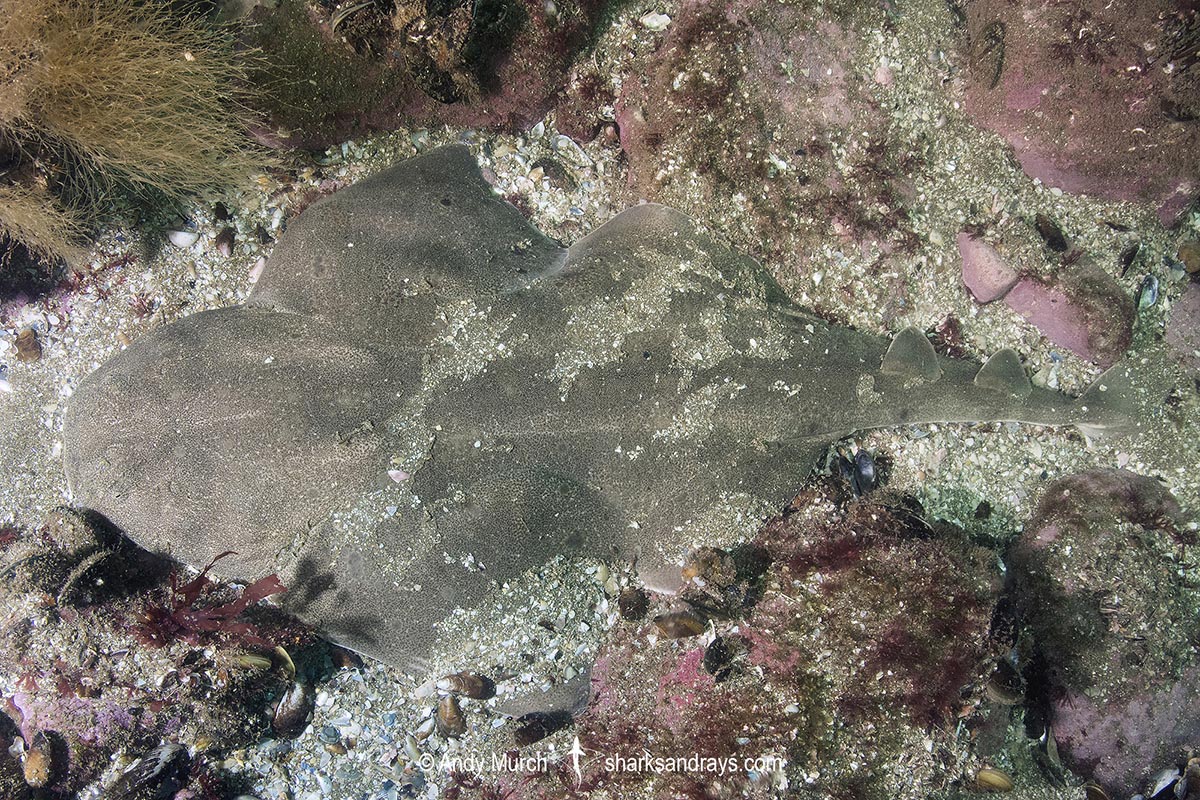Common name(s)
Angular Angelshark, Argentine Angelshark.
Binomial
Squatina guggenheim.
Synonyms
None.
Identification
A small angelshark species with a relatively long head that protrudes forward of the pectoral fin margins. Barbells have unfringed, slightly spatulate tips. Nasal flaps weakly fringed. Spiracle to eye width less than 1.5 eye size. Broadly concave forehead between eyes. Paired thorns (enlarged denticles) present on snout, between eyes, and between spiracles. Median dorsal row of thorns present along length of back. Pectoral fins relatively small with pointed apexes.
Dorsal coloration tan or grey-brown with a dense covering of very small dark spots, and a few paired, larger dark spots. Vague ocelli on pectoral fins. Ventrum pale.
Size
Maximum size 95 cm (Ebert et al. 2013). Size at birth 25-30cm.

Conservation Status
ENDANGERED
Although Angular Angelsharks are predominantly ambush predators, they are known to swim over the substrate in search of food at night, making them susceptible to capture in bottom-set gillnets that are set at night. In southern Brazil n 1992-1993 a gillnet fishery directly targeted angelshark populations on the outer shelf, causing severe declines.
Bottom trawling in Brazil (targeting a wide range of bony fishes)continues to deplete the Angular Angelshark population even though they were eventually protected in Brazil in 2004.
Squatina guggenheim is also a commercially important species in Argentina.

Habitat
Tropical and temperate sandy substrates often close to monumentation such as rocky reefs. Inshore and continental shelf. From 10m to at least 80m.
Distribution
Southwest Atlantic. Found from Rio De Janeiro in Brazil, southward to northern Patagonia in Argentina.
Reproduction
Like other squatinids, the angular angelshark is an aplacental viviparous species. 2-10 pups per litter. Pups develop in the uterus for the first four months before moving into the enlarged cloaca until born. Gestation period approximately 11 months. Reproductive cycle triennial.
Diet
Feeds on small demersal fishes and shrimps. The angular angelshark is an ambush predator that lays on the substrate partially covered by sand. When a fish swims within range, the angelshark explodes upwards from its concealment, mouth agape and clamps down on its prey.
Behavior
The angular angelshark remains motionless (waiting for prey to swim near its mouth) for long periods each day. Gravid females migrate into shallow water to give birth.
Reaction to divers
Easy to approach. Remains motionless, relying on camouflage. Will bolt if molested.
Diving logistics
The angular angelshark is rarely seen by divers but it is possible. I managed to track one down off the coast of Argentina near the town of Mar del Plata. Unfortunately, the southwest Atlantic is notoriously prone to storms so reaching offshore reefs where this species is most likely to be seen, is not particularly easy.
In November 2014, I waited three weeks for a 4hr window of opportunity, but did get to encounter this species in approximately 20m depth on a bank that was about 40 minutes from shore.
The best way to search for angelsharks is to swim along the edge of the reef, about 2m above the sand, in rocky or kelpy areas where the sharks have sand they can hide under and access to a good supply of fishes.
Although the shark will likely be buried under a fine covering of sand, their outline is often somewhat visible. Even if the outline of the angelshark is obscured, they always keep their eyes and spiracles exposed. After a few encounters, you should be able to pick out the signs of a shark’s presence more easily.
Once you have located a shark, with slow, non-aggressive movements, it is usually possible to settle down next to it and gently fan away most of the sand to get a better look. This does not distress the animal or significantly waste its energy because one or two pectoral fin flaps will completely cover it again. Be careful not to wave your hand too close to its mouth to avoid a demonstration of its incredibly fast bite reflex!
What’s new
View our full list of updates
Similar species
Argentine Angelshark Distinguished by shorter head, lack of thorns along midline, and bolder pattern of tightly spaced dark spots that are slightly smaller than eye size.
Hidden Angelshark Distinguished by two pairs of more elaborate ocelli (eye-like markings) on pectoral fins. Ocelli consist of yellowish circles edged in black, with small black pupil-like centres.



